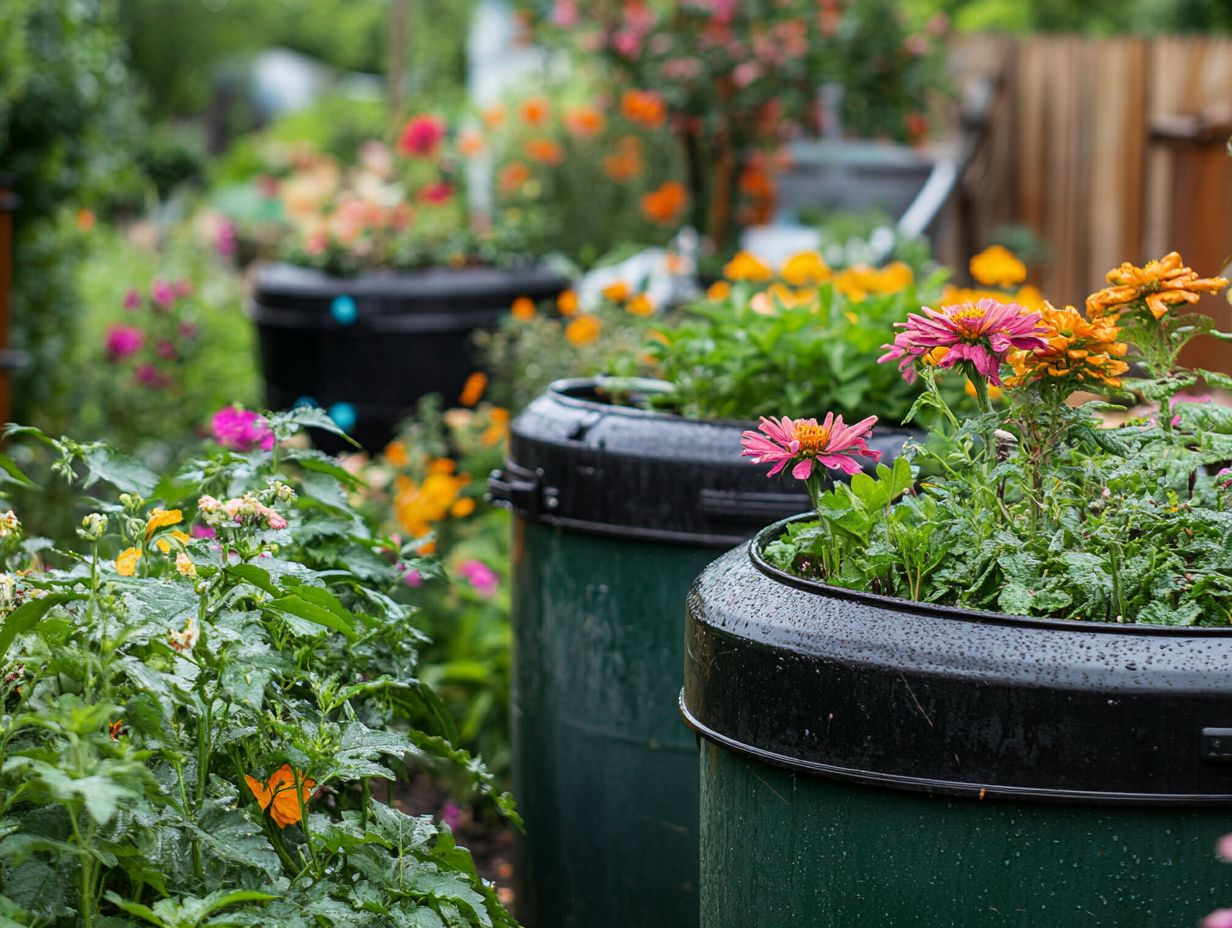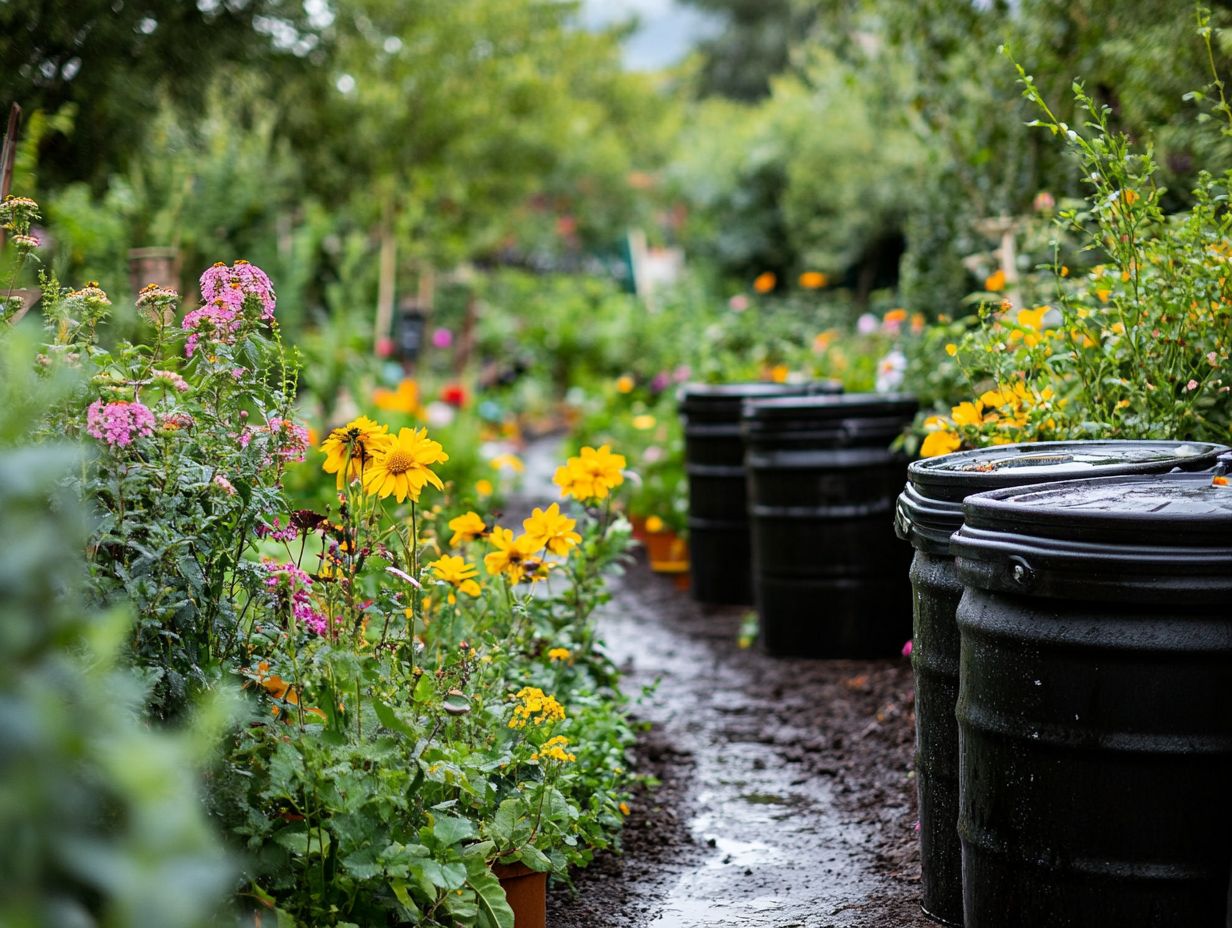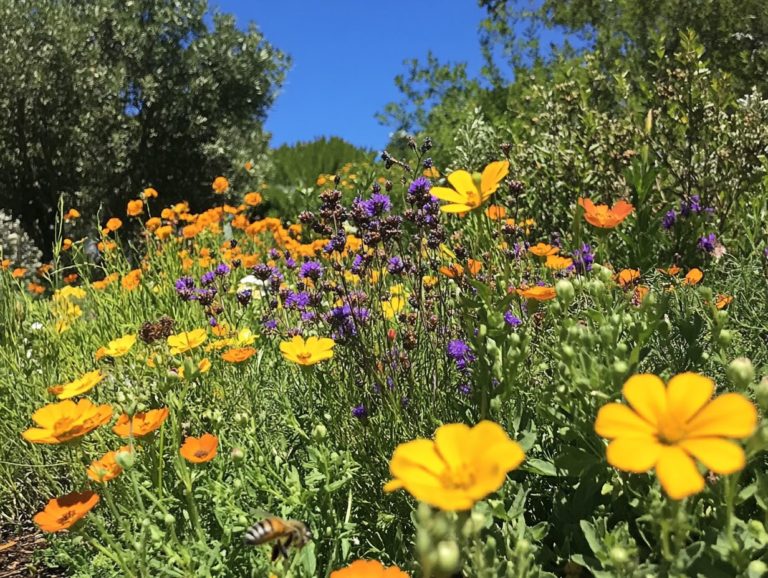Using Rain Barrels for Drought Gardening
Rain barrels are an excellent addition to your gardening toolkit, all while championing sustainability.
By collecting rainwater, you conserve valuable water resources, reduce your water costs, and enhance the health of your plants. This article delves into the myriad benefits of using rain barrels, provides a step-by-step guide for setting up your own system, and offers tips on maximizing rainwater for various plant types.
It also explores other ways to save water to elevate your gardening experience. Immerse yourself in this journey and discover just how simple and rewarding embracing rainwater harvesting can be!
Contents
- Key Takeaways:
- Benefits of Using Rain Barrels for Gardening
- How to Set Up a Rain Barrel System
- Get the Most Out of Rainwater for Your Garden!
- Alternative Water Conservation Methods for Gardening
- Frequently Asked Questions
- What are the benefits of using rain barrels for drought gardening?
- How do I set up a rain barrel for drought gardening?
- How often should I use the water from my rain barrel for drought gardening?
- Can I use rain barrel water for all of my plants?
- Do I need to empty my rain barrel before winter?
- What happens if my rain barrel overflows?
Key Takeaways:

- You ll save money and resources by using rain barrels for gardening.
- Proper installation and maintenance of rain barrels can improve plant health and reduce water costs.
- Maximize the benefits of rainwater by using it for different plants and implementing effective watering techniques.
Benefits of Using Rain Barrels for Gardening
Using rain barrels for your gardening endeavors presents a wealth of benefits. This practice not only conserves water but also elevates the overall health of your garden, especially when combined with insights from the best resources for drought gardening.
By collecting rainwater, you reduce water that runs off during rain, enhance water quality, and mitigate flooding all while providing a natural source of hydration for your plants.
In regions like Fort Michilimackinac, embracing this eco-friendly technique can significantly impact local conservation efforts, positioning you as an environmentally responsible gardener.
Conserving Water Resources
Conserving water resources stands out as one of the primary benefits of using rain barrels. These barrels allow you to collect and store precious rainwater for later use. This practice champions sustainable gardening and reduces your reliance on potable water essential for nurturing a thriving garden, especially during dry spells or droughts.
By collecting rainwater, you empower yourself to irrigate your plants with a resource that would otherwise contribute to water pollution. Effectively using rain barrels minimizes this harmful impact, fostering a sustainable ecosystem while supporting conservation efforts within your community.
Reducing Water Costs
Using a rain barrel can significantly lower your water bills, especially in areas like Morris, Illinois, where the demand for watering can be quite high. This practice conserves water and eases the load on city water systems, leading to substantial savings over time.
If you’re considering this eco-friendly solution, setting up your own DIY rain barrel is straightforward. Start with an old food-grade container, add a mesh screen to keep debris at bay, and incorporate a spigot for easy access to the collected rainwater.
Using upcycled products not only helps cut costs but also fosters a commitment to sustainable living. Crafting rain barrels from repurposed materials enhances water conservation, creating a win-win scenario for both the environment and your wallet.
Improving Plant Health
Using rainwater is a game-changer. It provides a natural source of hydration free from harmful chemicals often lurking in tap water.
This eco-friendly practice not only helps preserve groundwater but also delivers essential nutrients that promote robust growth in both edible and ornamental plants. When harnessed effectively, rainwater can enhance soil structure, boost microbial activity, and increase nutrient availability, creating a thriving haven for various plant species.
By employing specific watering techniques, such as drip irrigation or rain gardens, you can optimize water quality and ensure that every precious drop makes a difference. Whether you’re cultivating vibrant flowers or nutrient-rich vegetables, you ll witness remarkable transformations as the natural mineral content in rainwater fosters resilience and vigor across your diverse plant collection.
How to Set Up a Rain Barrel System

Setting up a rain barrel system is an effortless endeavor that gives you the power to efficiently harvest rainwater for all your gardening needs. Embrace this easy project to transform your gardening experience! Begin with the essential tools and equipment, including a diverter installation and a spigot attachment for convenient access.
This simple yet impactful setup allows you to make the most of nature’s resources while nurturing your garden.
Choosing the Right Barrel and Location
Choosing the right rain barrel and its installation location is essential for maximizing your rainwater collection and ensuring effortless access for watering your garden.
When you consider a rain barrel, size becomes an important point. Larger barrels can hold more water. However, they may demand additional space. The material of the barrel also plays a significant role in its durability and maintenance options like plastic and metal each come with their advantages. It s wise to seek out features such as mesh covers to keep debris at bay and first flow diverters. These devices help improve water quality by directing the first runoff away from the barrel.
Place your barrel on sturdy supports like cinder blocks. This prevents instability and helps with drainage. Locating it in areas that receive optimal rainfall ensures that it fills up efficiently, maximizing its value in nurturing a flourishing garden.
Installation and Maintenance Tips
Proper installation and regular maintenance of your rain barrel system can significantly enhance its efficiency and longevity, ensuring that your garden receives clean, contaminant-free water.
To achieve optimal results, carefully seal all plastic fixtures during installation to prevent leaks and ensure proper water flow. When it comes time to clean the barrel, a bleach solution effectively sanitizes surfaces and inhibits bacterial growth. Remember to consider water drainage requirements to avoid complications from pooling.
Regularly checking for debris accumulation is essential, as organic matter can lead to blockages and potential bacterial contamination. By implementing a mesh screen over the opening, you can effectively reduce debris infiltration while still allowing easy access for maintenance and cleaning out any residue when needed.
Get the Most Out of Rainwater for Your Garden!
To maximize your use of rainwater in gardening, it’s essential to grasp effective collection techniques and employ smart watering strategies. This approach not only ensures your plants flourish but also enhances sustainability throughout the growing season.
Watering Techniques and Timing
Implementing effective watering techniques and understanding the ideal timing for irrigation can significantly enhance the health of your garden. This helps prevent issues like soil erosion and poor water quality.
To achieve the best results, consider adopting deep watering methods. This approach encourages roots to dig deeper into the soil, boosting drought resistance while minimizing evaporation. Using mulch can be a game changer; it retains moisture in the soil and protects it from the sun s heat. Opt for early morning or late afternoon watering sessions to ensure maximum absorption and keep evaporation rates low.
By prioritizing soil health through these methods, you can cultivate a thriving ecosystem in your garden, leading to flourishing plants and vibrant landscapes that will be the envy of the neighborhood.
Using Rainwater for Different Types of Plants

Using rainwater for your plants whether they are edible or ornamental can significantly enhance their growth and yield. This is due to the pure, natural quality of this precious resource.
The good stuff plants need found in rainwater is free from harmful chemicals often lurking in tap water. This means it truly supports your plants’ health and vitality. For example, leafy greens thrive when nourished with rainwater; its natural minerals bolster the foliage and elevate the flavor.
Ornamental flowers can also benefit immensely, showcasing more vibrant colors and enjoying longer blooming periods. This is all thanks to the absence of chlorine and other additives. To make the most of these advantages, it’s essential to tailor your watering practices to meet the specific needs of your plants.
For drought-resistant varieties, consider less frequent but deeper watering. Tropical plants, on the other hand, may require more regular soakings to flourish at their best.
Alternative Water Conservation Methods for Gardening
In addition to rain barrels, explore other ways to conserve water that will not only enhance your garden maintenance but also foster sustainable practices within your community.
Other Ways to Conserve Water in the Garden
Consider integrating drip irrigation systems or soaker hoses in your garden to deliver moisture directly to the root zones. This is a highly effective way to conserve water.
Using mulching techniques will help keep the soil moist while effectively suppressing weeds. Opting for drought-resistant plants allows you to craft a stunning landscape that demands less water, contributing to a more sustainable environment.
Scheduling your irrigation during the cooler parts of the day can further reduce water loss due to evaporation. This ensures that every precious drop is utilized.
By combining these strategies, you enhance the health of your garden and contribute to a more resilient ecosystem. This highlights the vital role of responsible water management in promoting sustainable gardening practices.
Frequently Asked Questions
Here are some common questions people have about rain barrels and gardening:
What are the benefits of using rain barrels for drought gardening?
Using rain barrels for drought gardening can help conserve water and reduce your water bill. It also provides a natural source of non-chlorinated water for your plants, leading to healthier and more vibrant growth. Implementing water-saving gardening techniques for drought can further enhance your gardening efforts.
How do I set up a rain barrel for drought gardening?

First, choose a suitable location for your rain barrel, preferably near a downspout. Then, install a rain barrel diverter or attach a hose to the downspout to direct water into the barrel. Make sure to add a screen or cover to prevent debris and mosquitoes from entering the barrel.
How often should I use the water from my rain barrel for drought gardening?
It’s best to use the water from your rain barrel as soon as possible to prevent stagnation and bacteria growth. However, if you have a large barrel and/or receive frequent rainfall, you can use the water for several days before needing to refill.
Can I use rain barrel water for all of my plants?
Yes, rain barrel water is safe for all plants, including edible ones. Just be sure to avoid using it on any plants that are sensitive to chlorine, as some rainwater may contain trace amounts.
Do I need to empty my rain barrel before winter?
It’s recommended to empty your rain barrel before winter to prevent freezing and potential damage. However, you can also install a rain barrel heater or insulate the barrel to keep the water from freezing.
What happens if my rain barrel overflows?
If your rain barrel overflows, the excess water will flow out of the barrel’s overflow valve or hose. It’s important to regularly check and clean the overflow system to ensure proper drainage and prevent potential flooding in your garden.
Start using rainwater today to see a real difference in your garden!






